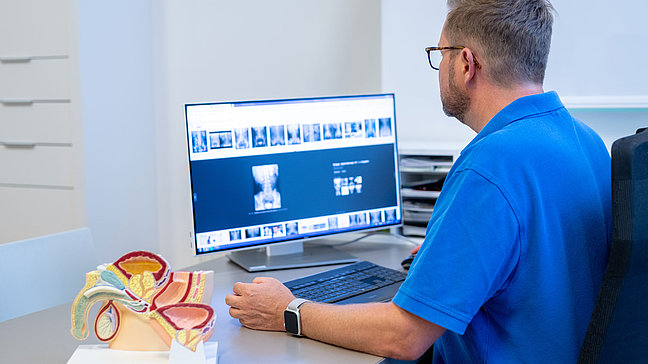
Chronic pelvic floor pain
Causes of chronic pelvic floor pain
The exact causes are often difficult to determine and can be varied. Possible causes include muscle tension, nerve irritation, inflammation and injury. Psychological factors such as stress and anxiety can also play a role. The exact cause often remains unclear and a multifactorial process is assumed.
Symptoms of chronic pelvic floor pain
- Pain in the perineum, urethra, prostate, bladder or groin area.
- Pain that worsens during sitting, sexual intercourse or urination.
- Feeling of pressure and tension in the pelvic area.
- Difficulty urinating or defecating.
Diagnosis of chronic pelvic floor pain
Diagnosis is based on a detailed medical history and physical examination by a urologist. Additional diagnostic measures may include imaging procedures such as ultrasound, MRI and specialized pelvic floor function tests. A bladder diary and pain assessment questionnaires can also be helpful.
Treatment options for chronic pelvic floor pain
Conservative: Treatment includes physical therapy, biofeedback, pelvic floor electrostimulation and trigger point therapy. Complementary medical methods such as phytotherapy (herbal medicine), cranio-sacral therapy and acupuncture can also be used.
Medication: Antispasmodic and pain-relieving medication is often recommended to alleviate the symptoms.
Ergonomic aids: Seat cushions or other supportive devices can help to reduce the pressure on the pelvic floor.
Psychotherapy: Psychotherapy can be helpful for psychological causes or as a supportive measure.
Preventive measures for chronic pelvic floor pain
Regular pelvic floor exercises to strengthen the pelvic floor muscles can have a preventative effect. Stress management techniques such as yoga or meditation and avoiding excessive pressure on the pelvic floor due to prolonged sitting or heavy lifting are also important.
Frequently asked patient questions about chronic pelvic floor pain
Chronic pelvic floor pain can be caused by various factors such as muscle tension, nerve irritation or previous operations.
Treatment options include physiotherapy, pain therapy and, in some cases, psychological support.
Yes, stress can exacerbate symptoms as it can increase muscle tension in the pelvic floor area.
The prognosis varies, but the symptoms can often be significantly alleviated with appropriate therapy.
A balanced diet can help reduce inflammation and promote overall health, which can indirectly affect symptoms.
![[Translate to English:]](/fileadmin/_processed_/1/d/csm_UZ-Logo-2024-breit-aK-1500px-white-red_4b49b8d28c.png)


